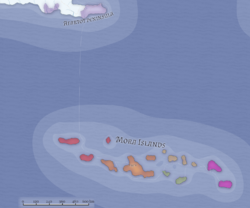Teivo
| South-East Moran language | |
|---|---|
| Teivo qii | |
 | |
| Pronunciation | [/ˈteɪ.βo.ʔiː/] |
| Created by | Raistas |
| Setting | planet Morev |
| Ethnicity | Jyrwutyr |
| Native speakers | 34 000 (271 local year) |
Moran
| |
Early form | Proto-Moran
|
Teivo (native name: teivo qii) is an Eastern Moran language spoken by the people, living on the islands of Tau and Imano - the eastern part of the Mora archipelago. The language is closely related to North-East Moran and even share its name with it (both teivo hia and teivo qii mean "language of the east").
The Teivo language, like its relatives, lacks an established orthography. Mtari scholars documented these languages using their own variations of the Mtari script, but the natives rarely know how to write. Nowadays the orthography of Gvahor is used for all Moran languages, created for his papers about the Moran culture and language and was the first to do a research on Moran grammar.
History
The Eastern Moran subgroup started developing after the Moran people had settled on the archipelago. Approximately 1,000 years ago they migrated to the Takimia islands where Teivo slowly developed into a separate language and about 500 years ago it split into Teivo Hia and Teivo Qii, so they still share a large degree of mutual intelligibility. South Moran is their closest common relative, which they share a few common innovations with.
Phonology
Teivo, belonging to the Eastern branch, has a quite distinct phonology from other Moran subgroups. Its phonetic inventory is the smallest among the Moran languages. Teivo retains typical Moran syllable structures of CV and VC. The CVC type is very uncommon, just like in proposed Proto-Moran.
Consonants
An unusual feature of the Eastern branch is the lack of sibilant fricatives. South-East Moran lacks fricatives all together, except for "v", which can be pronounced in a wide range of [β~v~w~ʊ] and some speakers do not pronounce it at all near rounded vowels, so "teivo" would become [ˈteɪ.o].
| Labial | Dental | Velar | Glottal | |
|---|---|---|---|---|
| Stop | p | t | k | ʔ[1] |
| Affricate | t͡s[2] | |||
| Nasal | m | n | ||
| Approximant | w~β[3] | r~ɾ~l[4] |
- ^ Can become a fricative /ɦ/ or even /ɣ/ in fast speech on the island of Tau, but typically is not pronounced at all, except word-initially.
- ^ Is an allophone of /t/ before /i/, but is also present sporadically in other environments.
- ^ The phonemes /w/ and /u/ are sometimes close in articulation, but /u/ is never elided, for example tauo ("straw") is always pronounced [ˈtaʊ.o]
- ^ The /r/ phoneme is most frequently realised as [ɾ], especially after long vowels and diphthongs, sometimes it is pronounced as [ɹ] and [r] (trilled) is preferred word-initially and before consonants and [l] can be found in the same environment in the speech of Tau.
All Teivo consonants, except for /w/ and /ʔ/ (written as "v" and "q" respectively) can be geminated, but they are considered consonant sequences and not separate phonemes.
Vowels
Teivo vowels can be short and long. Long vowels are pronounced for approximately twice as long as their short counterparts. They can be considered as either sequences of the short vowels, or counted separately as phonemes. The difference in quality between long and short vowels is very small.
| Front | Back | |
|---|---|---|
| Close | i, iː | u, uː[1] |
| Mid | e eː | o, oː |
| Open | a, aː | |
- ^ The /u/ phoneme is pronounced closer [ʉ], the long /uː/ is rare, but when present, is always a fully back vowel.
The Teivo diphthongs are not counted as separate phonemes, since they are historically sequences of two vowels and some speakers still pronounce them this way.
Phonotactics
Teivo phonotactics is often described using a term "mora" instead of a "syllable", which is a combination of a short vowel and a preceding consonant (if present). Long vowels, diphthongs and syllables with coda consonants are counted as two moras. With these units it is easier to set up morpheme boundaries and show conjugation patterns.
Orthography
| Consonants | Short vowels | Long vowels | |||||||||||||||||
|---|---|---|---|---|---|---|---|---|---|---|---|---|---|---|---|---|---|---|---|
| Phoneme | /p/ | /t/ | /k/ | /ʔ~Ø/ | /m/ | /n/ | /t͡s/ | /w~β/ | /r~ɾ~l/ | /a/ | /e/ | /i/ | /o/ | /u/ | /aː/ | /eː/ | /iː/ | /oː/ | /uː/ |
| Orthography | p | t | k | q | m | n | c | v | r | a | e | i | o | u | aa | ee | ii | oo | uu |